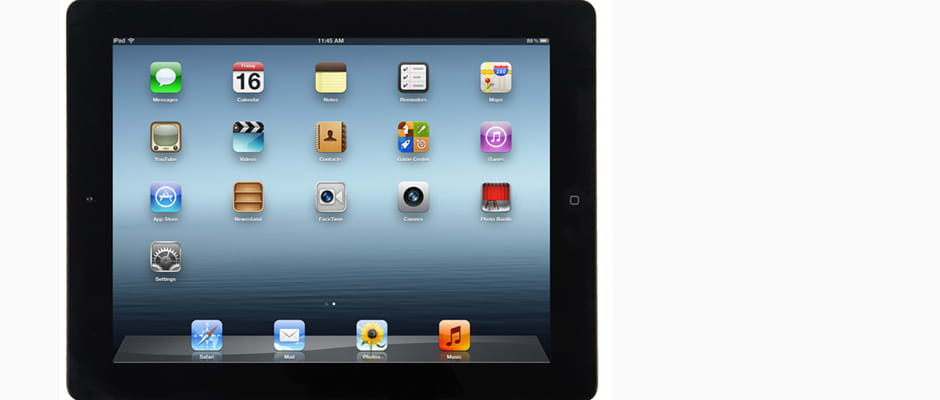Pros
Cons
Video Review
Introduction
Here it is, the new iPad. After much hype about the new Apple product, we're here to go over just how this hunk of metal and plastic fared in our labs. While the screen is certainly the best we've ever seen, the battery isn't, and it lacks the type of performance point like screen brightness to excuse that. Still, this is one of the most polished tablets on the market.
Front
{{section_header}}{{section.name}}{{/section_header}}
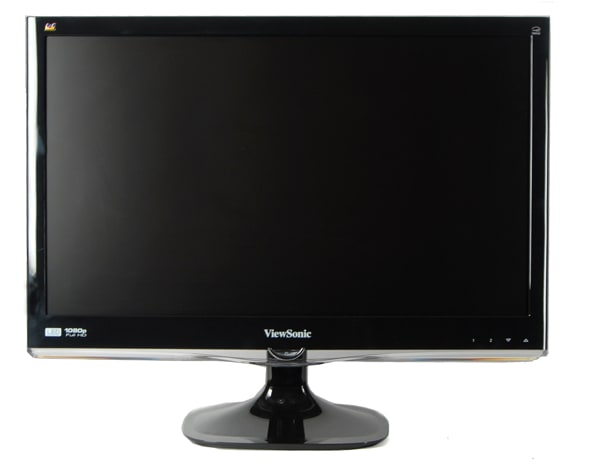
Back
{{section_header}}{{section.name}}{{/section_header}}

Sides
{{section_header}}{{section.name}}{{/section_header}}
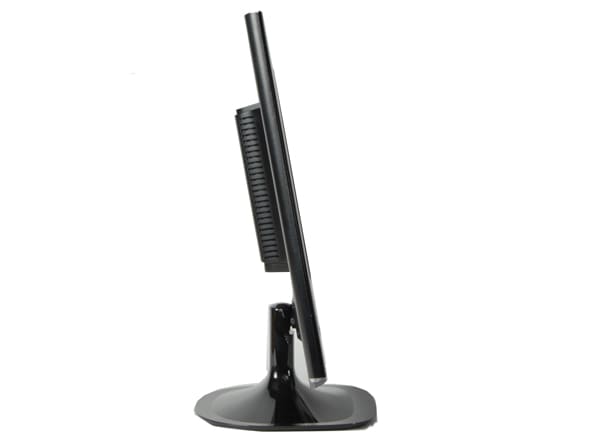
In the Box
{{section_header}}{{section.name}}{{/section_header}}
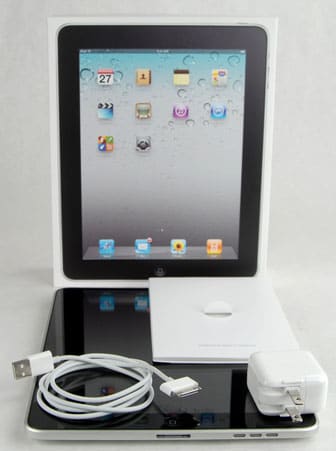
True to Apple's brand reputation, the box of the iPad is minimalistic, as is what comes in it. Inside, you will find your tablet, an interface cable, and a wall charger. Aside from a small amount of documentation, that's it.
Handling
{{section_header}}{{section.name}}{{/section_header}}
The new iPad is heavy compared to its predecessors, and if you're going to be using this thing for a long period of time, you may have a little bit of arm fatigue. The rounded edges fit well in the contour of the hand, and the added millimeter of thickness doesn't feel all that different. After a while, you'll start to notice that the iPad is getting warm; like, really warm. This isn't just your model, all of them seem to do this. We suggest getting a case with a stand.
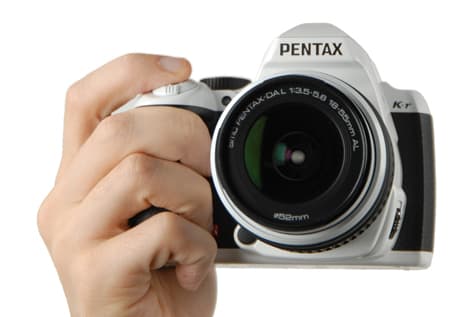
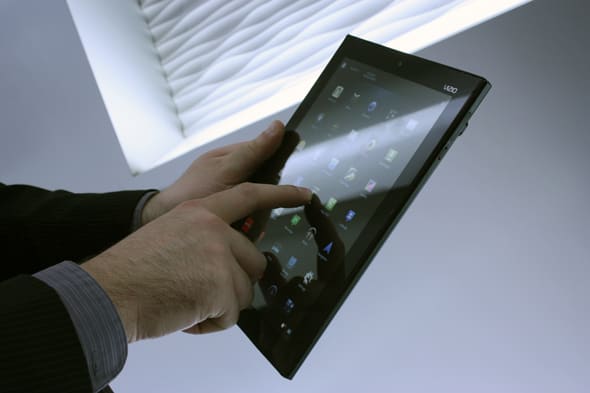
Screen
{{section_header}}{{section.name}}{{/section_header}}
While not as physically large as some of the other tablet screens out there, the screen of the new iPad is 7.5625 x 5.875 with an enormous resolution of 2046 x 1536 pixels. What does this mean for you? Well, aside from its net DPI of 264 pixels, its resolution makes it very close to a true retina display, meaning that the human eye can not distinguish the pixels in the screen if viewed by a person with 20/20 vision at a distance of over a foot. If you'd like to know more about the science behind this, check out Dr. Raymond Soneira on the subject.
As it had in the previous iterations, the new iPad has a capacitive touchscreen that will allow you exceptionally precise control of the touch controls of the user interface, iOS 5.

Indoor & Outdoor Use
{{section_header}}{{section.name}}{{/section_header}}
One of the biggest shortcomings of tablets with LCD screens in general is the fact that they not only are highly reflective, but also cannot function well outdoors by the very nature of how they work. Because they rely on a backlight to overpower the ambient light and display their image, bright sunlight will make the image look washed-out and difficult to see, so don't plan on taking your tablet to the beach. Still, if you keep your iPad out of direct sunlight, you should have some degree of success.
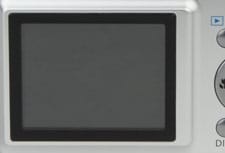
NOTE: The images above are shot with a variety of lighting sources, which may cause some color shift.
Legibility
It should come as no surprise that a screen with a resolution that has just under double the DPI of other tablets is incredible from a legibility standpoint. If you look super-closely, you can see that each pixel is roughly 1/4th the size of the competitors’ pixels. Impressive, no? Held at more than 1 foot away from your face, an adult with normal vision should not be able to see the lines of pixels.

Reflectance
Much like every other tablet with an LCD screen, however, there is the huge downside of a highly reflective screen. Despite the ferociously-named gorilla glass coating, it doesn’t do much to maul light that hits the screen, and it reflects about 25.8% of it back at you, 8.6% of it directly.
As you can imagine, this issue, coupled with the fact that LCD screens typically are not bright enough to be seen in direct sunlight, makes the Apple iPad something that should never really see the bright sun, as you won’t really be able to see the picture.
Screen Size & DPI
As previously discussed, the iPad has a screen size of 7.5625 × 5.875 and a resolution of 2046 × 1536, netting it a DPI of 264, which is absolutely bananas compared to the tablets its meant to compete with. By doing this, Apple gives users a small bit of insurance for the future, as many photos and other content can often exceed the standard 720p resolution most tablets seem to hover around.
Keep in mind, though, that currently the Apple’s iTunes store sells videos at a maximum of 1080p, so you won’t be getting every ounce of performance out of the screen unless you have other content available. Still, your tablet will be able to render 1080p content with minimal scaling issues, so do not worry.
Blacks and Whites
With a decided improvement in contrast performance, the Apple iPad provides a good quality picture. As the Apple iPad has a good black level and a decent peak brightness, our tests show that the iPad hangs with the best of them in terms of black and white performance by the numbers.
Color Gamut
Wow. When we initially heard Apple’s claims that its gamut was “40% better,” we weren’t sure exactly what to think. Well, looking at what we found with our photospectrometer, we can see that there was a drastic improvement, and possibly the best color gamut so far. While there is a certain level of error, and a shift in the blues, this screen is by far and away the most accurate on the market.
Battery Life
Well, we finally finished our battery tests, and the results are extremely underwhelming. While we believe that there’s the high probability that the screen brightness plays a factor in this one, the new iPad lags behind the competition, and even its previous iteration, the iPad 2. It would be one thing if the performance was able to offset the cost in worse battery life, but not only did the iPad fall behind in battery life with all additional processes terminated and the backlight cranked, but it did so with the WiFi and location services turned off.
Considering the size and weight of the battery, it’s a little baffling that it can’t quite defeat the competing Android tablets in battery life, especially considering that they outperform the new iPad in terms of screen brightness by a large margin, many times exceeding 100 cd/m2. Perhaps in time Apple will release a software upgrade that will help the new iPad with resource management, but this score is just bad considering the iPad’s former throne as “best on the market.” On top of all this, the battery itself takes far longer to charge than most tablets, often taking 5+ hours to charge completely.
Controls
{{section_header}}{{section.name}}{{/section_header}}
Because most of the controls for the {{product.name}} are accessed through the capacitive touchscreen, there are very few physical controls at all. To wit, only the home button, power button, and volume button survived the great controls through the user interface. So far, not much has changed from the iPad 2 with iOS 5, as the software is virtually identical. For a full write-up of the iOS 5 operating system, including screenshots and walkthroughs, visit our iOS 5 Explored page.
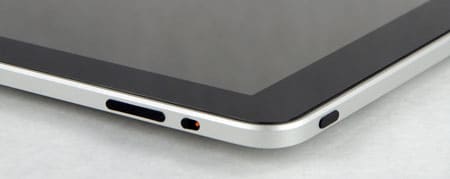
The controls on the top right side of the iPad body: volume, lock and power.
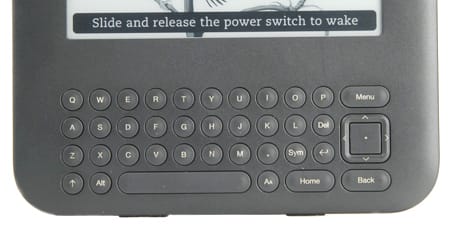
One of the other major draws to the iPad is the fact that you can stream and display content on your home television using Apple's AirPlay system. While it's no IR-blaster to control your home theater setup completely, it does allow you to use your iPad as a media source for your setup at home. Once you've opened the app and discovered your device, you can mirror your content on your TV, play back video, music, or pictures, or just use your screen as you would a computer monitor. It's roughly another $100 via a separate purchase of the AppleTV unit, but it's an item to consider.
Connectivity
{{section_header}}{{section.name}}{{/section_header}}
The new {{product.model}} has some serious wireless capability that merits a second look no matter what tablet you're looking to pick up. Even the WiFi "only" version has an 802.11n wireless card, as well as Bluetooth 4.0, allowing high-speed data transfer and peripheral use. While it has no IR blaster, or anything fancy like that, you can control your TV via an AirPlay device if you're willing to shell out for it.
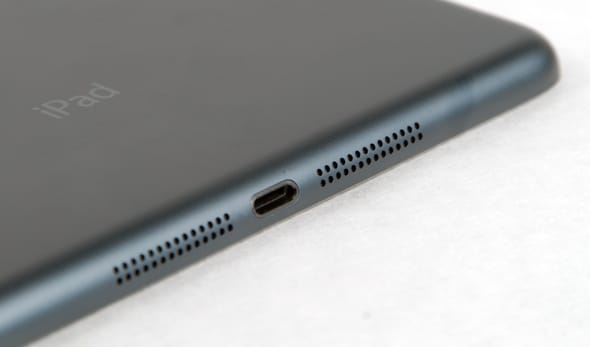
Here we see a Lightning dock in its natural habitat.
If you are willing to shell out a little extra cash, you can also get a 4G LTE version of the new iPad, allowing you to roam free from WiFi hotspots. While we do not do speed tests on networks, much of the downloadable content isn't huge, so you should be fine if you have a good connection.
Battery Life
{{section_header}}{{section.name}}{{/section_header}}
Well, we finally finished our battery tests, and the results are extremely underwhelming. While we believe that there's the high probability that the screen brightness plays a factor in this one, the new iPad lags behind the competition, and even its previous iteration, the iPad 2. It would be one thing if the performance was able to offset the cost in worse battery life, but not only did the iPad fall behind in battery life with all additional processes terminated and the backlight cranked, but it did so with the WiFi and location services turned off.
Considering the size and weight of the battery, it's a little baffling that it can't quite defeat the competing Android tablets in battery life, especially considering that they outperform the new iPad in terms of screen brightness by a large margin, many times exceeding 100 cd/m2. Perhaps in time Apple will release a software upgrade that will help the new iPad with resource management, but this score is just bad considering the iPad's former throne as "best on the market." On top of all this, the battery itself takes far longer to charge than most tablets, often taking 5+ hours to charge completely.
Reading Books
{{section_header}}{{section.name}}{{/section_header}}
Reading eBooks on an iPad is a very rewarding experience, battery drain aside. While you probably won't reap the full benefit of the retina display, you will be greeted with a crisp image that greatly resembles luminous text on a page. Page controls are natural, including a tap or swipe to flip through pages, holding down your finger to mark up or select text, and even some social media applications.
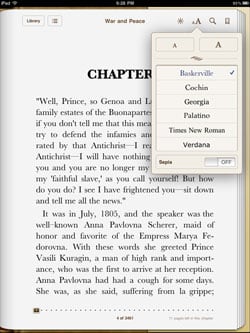
The iBooks program offers a range of controls for font and text size
If you find that the color of the pages don't suit you (and bright white light can be very distracting), you can change the color of the background to black or sepia. You can also change fonts and font sizes, if that helps. The eReader app works at either portrait or landscape orientation, as some users find one or the other easier to hold. While a tablet is not exactly the ideal platform to read an eBook on compared to, say, an eReader, it is quite nice to have that ability when you want to read at night without disturbing your partner.
Buying Books
{{section_header}}{{section.name}}{{/section_header}}
Buying books through the iBook Store is very simple, and works very much like it does in the iTunes store for music; once you've entered your billing information in your Apple account, you can simply search for a title you'd like to buy or download, and tap the "purchase" icon. Your title should begin downloading once your credit card clears, and you'll be reading your new book in no time.
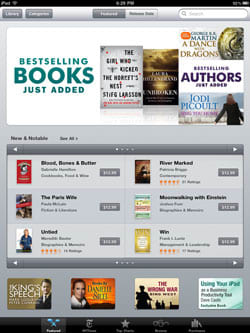
Books can be purchased on the iPad through the iTunes store
eBook Formats
{{section_header}}{{section.name}}{{/section_header}}
Because the iPad has access to the expansive App Store, your eBook formats are really only limited to whichever eReader software you prefer. The iBook app has file format support for the iBook format, PDF files, and .txt files, but by downloading any of the other apps, or using conversion software (Calibre is a good choice), you can make sure your library isn't lost between platforms.
{{product.manufacturer_specs['eBook Formats Image']}}
On top of all that, if you are comfortable using the iBook app over a competitor like the Kindle App, you will be able to use Apple's iCloud storage to make sure you can make the most of your hard drive space should you decide to stow away titles from your library for a while. Amazon offers a similar service for their customers, but this one's up to you.
Newspapers & Magazines
{{section_header}}{{section.name}}{{/section_header}}
The newsstand app allows you to download issues of, or subscribe to your periodicals of choice. By entering into the Newsstand Store, you can browse titles, and explore a litany of recommendations and popular periodicals. Many of these read the same way as an eBook, as they are viewed with the same program.
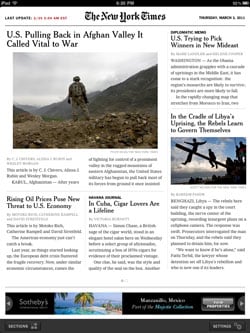
The New York Times is available on the iPad through their own app
Music & Audio Controls
{{section_header}}{{section.name}}{{/section_header}}
Users of the iPod touch will recognize the playback screen anywhere. While the scale of some of the elements are very different, the layout is essentially the same. There's a scrub bar at the top, along with track information, album art in the middle, and volume slider at the side. Advanced playback options can be accessed by tapping the appropriate icon.
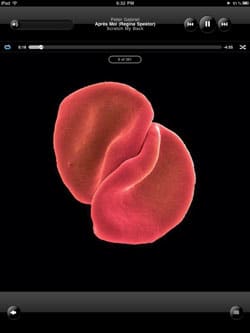
The iPod app shows the cover art while playing music
Music & Audio Management
{{section_header}}{{section.name}}{{/section_header}}
The iPad uses virtually the same interface as the iPod touch does, and if you're familiar with that, you're golden. If not, we can walk you through it. All of your music is managed by the iTunes program on your home computer, which you can sync your device with. Once you do that, your library of music (what you've selected to be synced, anyway) should be uploaded onto your device, and you can easily navigate through your music by song title, artist, album, genre, or playlist.
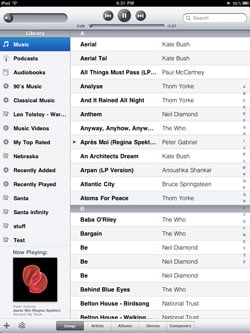
Audio files can be sorted by title, artist, album, genre or composer
If you'd like, you can even create your own playlists from the iPad. As far as portable media devices go, the iPad makes it easy with its straightforward process. Visit our iOS explored page for a more detailed description of the process.
Music & Audio Battery Life
Video Controls
{{section_header}}{{section.name}}{{/section_header}}
Video controls are the same as they would be on any other iOS 5 device: the play/pause button at the bottom of the screen along with the fast forward/rewind buttons disappear after a few moments to make way for your video content. Overall, it's a fairly simplistic interface, but that's great: you don't want an overly complicated mess of control governing your video usage.

Video Management
{{section_header}}{{section.name}}{{/section_header}}
Videos are managed by iTunes on your computer, and on the video app of your iPad. Their layout is more or less analagous to how music is sorted, keeping a uniform interface for downloaded media.
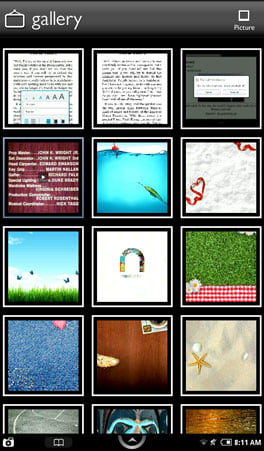
The gallery is used to navigate videos, and only offers thumbnails
Video Formats
Internet Video
{{section_header}}{{section.name}}{{/section_header}}
The iPad remains one of the best streaming platforms on the market (or at least, easiest to use). With the presence of several different clients in the App store, and a YouTube app pre-installed, you can choose between a boat-load of streaming clients for your online video, assuming you have a reliable connection. Controls are very much the same as they would be with another file, unless the app itself has a native control scheme (like Netflix does).

Video Battery Life
{{section_header}}{{section.name}}{{/section_header}}
The email app is great if you just want a central place to link you POP/IMAP/Exhange/GMail accounts instead of jumping from place to place. Overall, it's a very basic client, but it does the job. Read more about the iOS 5 email app.
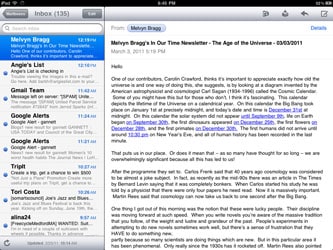
The iPad email app is basic, but adequate for most users
Web Browsing
{{section_header}}{{section.name}}{{/section_header}}
The Safari browser on the iPad is startlingly similar to what you'd find on a computer. The aesthetics are virtually identical to the computer-based browser, and the functionality is very much the same. This is a very good browser to cut your tablet-using teeth on if you're making the jump from computer to tablet. If you would like to read an in-depth description of the Safari browser on iOS 5, check out our description in our iOS article.
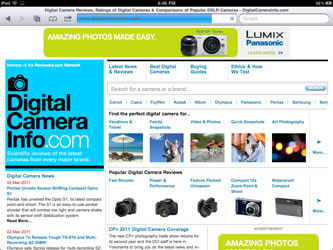
The iPad boasts a fully featured Safari web browser
Internet Apps
{{section_header}}{{section.name}}{{/section_header}}
To start, the Apple App store is the reigning king of the app market. With over 200,000 apps and countless partnerships and the leading market share, Apple is currently king of Apps. Long famed for having an app for just about anything, the same perception still holds true, despite the competition from Google and Amazon.

To purchase an app, all you have to do is search the App Store for something you want or need, then tap the purchase/download button. It's that simple. If you would like to know more, click here.
Other Internet Features
{{section_header}}{{section.name}}{{/section_header}}
Because there's such a huge list of internet features available on the iPad, it's hard to determine what to discuss. You can video chat with friends, make and share videos and presentations, stream all sorts of media, the list goes on. The iPad is one of the best-supported tablets on the market, but you have to buy apps to unlock some of the most fun capabilities of your tablet.
{{product.manufacturer_specs['Other Internet Features Image']}}
Apple iPad 2
{{section_header}}{{section.name}}{{/section_header}}
Device & Specs
The device comparison here really isn't fair, but let's recap how the new iPad is different from the iPad 2: it has a quad-core GPU (though only dual-core CPU), a much larger battery, it's 1mm thicker, bluetooth 4.0, a better camera (5MP), and oh yeah, an incredible screen. The iPad 2 isn't a bad tablet either, but the new iPad is definitely going to be closer to what is competitive for the next year. The iPad 2 has a much smaller resolution, smaller battery, smaller processor, smaller camera, and smaller amount of RAM (512MB vs. 1GB).
Screen
Another unfair comparison, the new iPad blows its predecessor out of the water by having around double the resolution, better contrast ratio, and an unbelievable color gamut for a tablet.
Battery
eReader
Because both operate off of the same operating system, there is virtually no difference here outside of text crispness, which really shouldn't matter to you.
Internet
Here too, both have virtually identical internet features, as both run off of iOS 5. The new iPad is more likely to be updated for longer, though, so this might change in 2 years.
Motorola Xyboard
{{section_header}}{{section.name}}{{/section_header}}
Device & Specs
Android devices made their name off of blowing Apple products' hardware out of the water, but the new iPad makes a bold statement. Catching up to the Android pack by offering its dual core processor, it matches the Xyboard in RAM as well. The Xyboard isn't without its own tricks up its sleeve, however, as it has an IR blaster to control your entire home theater without additional purchases. Still, it can't match the performance of the new iPad's screen, nor can it boast the same app store support. Ultimately, it's up to you what you want, but there are some key differences like the Xyboard's waterproof nano-coating to consider here.
Screen
The Xyboard's screen can't compare to the new iPad's in terms of resolution or raw performance, but it is much brighter, allowing it to be taken outside.
Battery
eReader
Because both tablets have access to almost all of the same eReader apps outside of iBook, there is virtually no difference here, aside from the fact that the Xyboard is easier to hold for long periods of time.
Internet
Whether Android fans like to admit it or not, Apple has the larger application store, but that doesn't mean the Google Play Store should be dismissed: it has a lot of the apps that Apple doesn't tolerate (think torrenting, using bluetooth for off-label use, etc.). You'll have to decide for yourself, but Android's Play Store warrants a second look if you're most concerned with apps.
Amazon Kindle Fire
{{section_header}}{{section.name}}{{/section_header}}
Device & Specs
Because the main draw to Amazon's tablet is the fact that it can be had for $199 plus shipping, it's not surprising that its hardware falls far short of what you get with the iPad. With a 7-inch screen that's intensely bright, the Kindle Fire does fare better in the outdoors than the iPad, but the inferior app market, inferior software, inferior processor, inferior RAM, and generally basic features aren't enough to satisfy someone who wants their tablet to do everything. If you don't need much in a tablet, the Fire is a great pickup, but it's no iPad.
Screen
The screen of the Fire is smaller, and has a resolution of 1024 x 600. The iPad, on the other hand is larger (9.7 inches) and has a near-retina display with a resolution of 2046 x 1536 pixels. While most content hasn't caught up to display technology, the iPad will survive the coming years much better than the Fire will.
Battery
eReader
Hands-down the Kindle Fire is the better eReader, as unpopular as this sentiment is. Because the unit itself is smaller, brighter, and has all of the benefits of Amazon's lending library program, you can really flex your mind with a dizzyingly-large amount of eBooks. Even though the iPad can install the Kindle app, it is harder to read for long periods of time, and more expensive the more you buy.
Internet
On the other side, the iPad is hands-down one of the best-supported devices for internet content, especially if you plunk down the extra coin for the LTE version to have access anywhere there's a 4G connection. Not only is the Apple App Store much more content-rich and diverse, but the interface is less stuttery, and the final product much more polished.
Conclusion
Now that we've finished testing the new iPad, what we've seen so far is very impressive: its screen is amazing for a tablet, it has the same established operating system that other iOS devices have, and it doesn't try to re-invent the wheel. Many of the features on the new iPad are things that exist on the old ones, but they've been improved to compete with 2012's crop of tablet contenders. It's a smart release for Apple.
That's not to say that there aren't a couple areas of concern, as the device itself is still a bit on the heavy side, and it doesn't have some of the features that set some of the better Android tablets apart from the pack. On top of this, there is the issue of the unit overheating rather quickly, and a battery life that fails to compete with other high-end tablets. While the screen is impressive, the hardware itself doesn't do much to make a name for itself, especially considering Apple stuck with a dual-core CPU, and seems to be playing catchup to other tablets.
Where the iPad does shine is its software: with Apple's great interface, and a stunningly-crisp screen, the iPad is probably the most polished machine we've run across. While there are fans and detractors of everything Apple, the performance points stand on their own, and if you believe that this is the tablet for you, we feel that we've given you the best picture possible before buying it.
Meet the tester
A seasoned writer and professional photographer, Chris reviews cameras, headphones, smartphones, laptops, and lenses. Educated in Political Science and Linguistics, Chris can often be found building a robot army, snowboarding, or getting ink.
Checking our work.
Our team is here to help you buy the best stuff and love what you own. Our writers, editors, and experts obsess over the products we cover to make sure you're confident and satisfied. Have a different opinion about something we recommend? Email us and we'll compare notes.
Shoot us an email